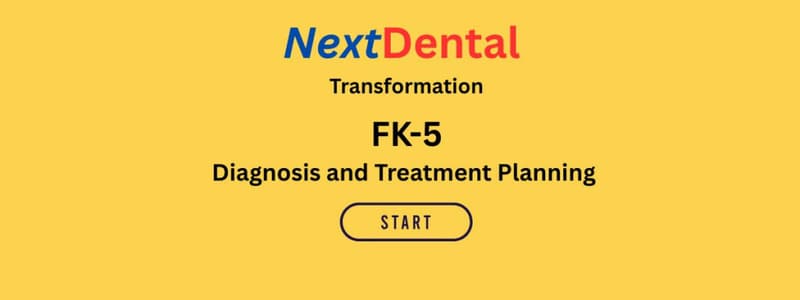Podcast
Questions and Answers
A patient presents with painful, recurrent oral ulcerations that have persisted for over a month. Which immunological mechanism is most likely involved in the pathogenesis of these lesions?
A patient presents with painful, recurrent oral ulcerations that have persisted for over a month. Which immunological mechanism is most likely involved in the pathogenesis of these lesions?
- IgE-mediated hypersensitivity
- Antibody-dependent cell-mediated cytotoxicity
- T-cell mediated cytotoxicity (correct)
- Complement activation via the classical pathway
During a dental exam, you note several areas of gingival inflammation with bleeding upon probing. An increased presence of which cell type would be expected in the gingival crevicular fluid as an initial response?
During a dental exam, you note several areas of gingival inflammation with bleeding upon probing. An increased presence of which cell type would be expected in the gingival crevicular fluid as an initial response?
- Macrophages
- Lymphocytes
- Neutrophils (correct)
- Plasma cells
A patient reports a history of anaphylactic reactions to certain medications. When planning dental treatment, which immune mechanism should be of primary concern?
A patient reports a history of anaphylactic reactions to certain medications. When planning dental treatment, which immune mechanism should be of primary concern?
- Complement-mediated lysis
- IgE-mediated hypersensitivity (correct)
- Delayed-type hypersensitivity
- IgG-mediated antibody-dependent cytotoxicity
In the progression of periodontal disease, which cytokine plays a significant role in alveolar bone resorption by stimulating osteoclast activity?
In the progression of periodontal disease, which cytokine plays a significant role in alveolar bone resorption by stimulating osteoclast activity?
A dental implant procedure leads to peri-implantitis. Dysregulation of which host defense mechanism contributes to the progression of this condition?
A dental implant procedure leads to peri-implantitis. Dysregulation of which host defense mechanism contributes to the progression of this condition?
What is the primary concern regarding the immune response during dental treatment for a patient with a history of organ transplantation on immunosuppressive medications?
What is the primary concern regarding the immune response during dental treatment for a patient with a history of organ transplantation on immunosuppressive medications?
Which cells are primarily responsible for the adaptive immune response to periodontal pathogens through the production of antigen-specific antibodies?
Which cells are primarily responsible for the adaptive immune response to periodontal pathogens through the production of antigen-specific antibodies?
A patient presents with a localized, fluctuant swelling in the gingival tissue associated with a non-vital tooth. Which host defense mechanism is primarily attempting to contain this infection?
A patient presents with a localized, fluctuant swelling in the gingival tissue associated with a non-vital tooth. Which host defense mechanism is primarily attempting to contain this infection?
In the context of wound healing following oral surgery, which immune cells play a crucial role in debridement and the transition to tissue repair by releasing growth factors and cytokines?
In the context of wound healing following oral surgery, which immune cells play a crucial role in debridement and the transition to tissue repair by releasing growth factors and cytokines?
A patient with a viral infection develops oral lesions with epithelial cell damage. Which immune cells are most likely mediating the destruction of these infected cells?
A patient with a viral infection develops oral lesions with epithelial cell damage. Which immune cells are most likely mediating the destruction of these infected cells?
The effectiveness of a dental vaccine for a specific oral pathogen would primarily rely on stimulating which arm of the immune system?
The effectiveness of a dental vaccine for a specific oral pathogen would primarily rely on stimulating which arm of the immune system?
A patient experiences a delayed allergic reaction to a component of a dental material, manifesting as contact dermatitis around the mouth. Which type of hypersensitivity reaction is most likely involved?
A patient experiences a delayed allergic reaction to a component of a dental material, manifesting as contact dermatitis around the mouth. Which type of hypersensitivity reaction is most likely involved?
Which non-immune defense mechanism in the oral cavity acts as a physical barrier and contains antimicrobial substances like lysozyme?
Which non-immune defense mechanism in the oral cavity acts as a physical barrier and contains antimicrobial substances like lysozyme?
During the formation of dental caries, initial demineralization of enamel is facilitated by acids produced by bacteria. Which host immune factor in saliva helps neutralize these acids and inhibit demineralization?
During the formation of dental caries, initial demineralization of enamel is facilitated by acids produced by bacteria. Which host immune factor in saliva helps neutralize these acids and inhibit demineralization?
A patient with a compromised immune system due to chemotherapy is at an increased risk of opportunistic oral infections, like oral candidiasis (thrush). This occurs due to a deficiency in which aspect of host defense?
A patient with a compromised immune system due to chemotherapy is at an increased risk of opportunistic oral infections, like oral candidiasis (thrush). This occurs due to a deficiency in which aspect of host defense?
What is the primary role of salivary Immunoglobulin A (sIgA) in oral health?
What is the primary role of salivary Immunoglobulin A (sIgA) in oral health?
When treating oral infections with antibiotics, considering the potential for antibiotic resistance is important. Which is a host-related factor that can influence the outcome of antibiotic therapy?
When treating oral infections with antibiotics, considering the potential for antibiotic resistance is important. Which is a host-related factor that can influence the outcome of antibiotic therapy?
During diagnosis of certain oral lesions, a biopsy is done to examine cellular infiltrate. The predominance of lymphocytes in a chronic inflammatory lesion suggests what type of immune response is involved?
During diagnosis of certain oral lesions, a biopsy is done to examine cellular infiltrate. The predominance of lymphocytes in a chronic inflammatory lesion suggests what type of immune response is involved?
Autoimmunity, where the immune system attacks self-antigens, can manifest in the oral cavity as conditions like Sjögren's syndrome. Which of the following is a key characteristic of autoimmune diseases?
Autoimmunity, where the immune system attacks self-antigens, can manifest in the oral cavity as conditions like Sjögren's syndrome. Which of the following is a key characteristic of autoimmune diseases?
When planning treatment for a patient with a known latex allergy, it is crucial to avoid triggering which immune response?
When planning treatment for a patient with a known latex allergy, it is crucial to avoid triggering which immune response?
Flashcards
What is T-cell mediated cytotoxicity?
What is T-cell mediated cytotoxicity?
A type of cell-mediated immune response where cytotoxic T cells directly kill target cells, such as oral keratinocytes.
What are neutrophils?
What are neutrophils?
White blood cells that are among the first to respond during gingivitis to combat bacterial biofilm.
What is Anaphylaxis?
What is Anaphylaxis?
A life-threatening allergic reaction mediated by IgE antibodies, which trigger the release of histamine from mast cells and basophils.
What is Tumor necrosis factor-alpha (TNF-α)?
What is Tumor necrosis factor-alpha (TNF-α)?
Signup and view all the flashcards
What imbalance contributes to peri-implantitis?
What imbalance contributes to peri-implantitis?
Signup and view all the flashcards
What is the primary concern for transplant patients?
What is the primary concern for transplant patients?
Signup and view all the flashcards
What are plasma cells?
What are plasma cells?
Signup and view all the flashcards
What is Recruitment of neutrophils?
What is Recruitment of neutrophils?
Signup and view all the flashcards
What are macrophages?
What are macrophages?
Signup and view all the flashcards
What are Cytotoxic T lymphocytes (CTLs)?
What are Cytotoxic T lymphocytes (CTLs)?
Signup and view all the flashcards
What is adaptive immunity?
What is adaptive immunity?
Signup and view all the flashcards
What is Type IV hypersensitivity reaction?
What is Type IV hypersensitivity reaction?
Signup and view all the flashcards
What is the oral mucosa?
What is the oral mucosa?
Signup and view all the flashcards
What is the bicarbonate buffer system?
What is the bicarbonate buffer system?
Signup and view all the flashcards
T lymphocytes and phagocytes' function
T lymphocytes and phagocytes' function
Signup and view all the flashcards
What is slgA's function?
What is slgA's function?
Signup and view all the flashcards
What is the patient's underlying immune status?
What is the patient's underlying immune status?
Signup and view all the flashcards
What is Adaptive immune response?
What is Adaptive immune response?
Signup and view all the flashcards
What is a breakdown of self-tolerance?
What is a breakdown of self-tolerance?
Signup and view all the flashcards
What is IgE antibodies binding to latex allergens?
What is IgE antibodies binding to latex allergens?
Signup and view all the flashcards
Study Notes
- Recurrent oral ulcerations are often linked to a T-cell mediated inflammatory response where cytotoxic T cells attack oral keratinocytes
Gingivitis
- In early gingivitis, neutrophils migrate into gingival tissues to fight bacterial biofilm.
Anaphylaxis
- Anaphylaxis, a life-threatening allergic reaction, is mediated by IgE antibodies causing histamine release from mast cells and basophils.
Periodontal Disease
- Tumor necrosis factor-alpha (TNF-α) is a cytokine that stimulates osteoclast activity, crucial in alveolar bone resorption during periodontal disease.
Peri-implantitis
- An imbalance between pro- and anti-inflammatory mediators causes a chronic inflammatory response, leading to tissue destruction.
Organ Transplantation
- Immunosuppressive medications weaken the immune system, leading to increased susceptibility to bacterial, viral, and fungal infections in the oral cavity.
Adaptive Immune Response
- Plasma cells, differentiated B lymphocytes, produce antigen-specific antibodies against periodontal pathogens.
Acute Bacterial Infection
- In acute bacterial infections like dental abscesses, neutrophils are rapidly recruited to the infection site to engulf and destroy bacteria
Wound Healing
- Macrophages are essential for resolving inflammation, promoting wound healing, phagocytosing debris, and releasing factors for fibroblast proliferation and angiogenesis.
Viral infections
- Cytotoxic T lymphocytes (CTLs) recognize and kill virus-infected cells by inducing apoptosis that is key in controlling viral infections
Vaccines
- Vaccines stimulate the adaptive immune system that generates antigen-specific antibodies and memory T cells that gives long-lasting protection against infections
Contact Dermatitis
- Contact dermatitis is a Type IV or delayed-type hypersensitivity reaction mediated by sensitized T cells releasing cytokines upon re-exposure to an allergen.
Oral Mucosa
- The oral mucosa acts as a physical barrier and contains antimicrobial substances like lysozyme for non-specific defense.
Saliva
- The bicarbonate buffer system in saliva neutralizes acids produced by oral bacteria, maintaining a neutral pH and preventing enamel demineralization.
Opportunistic Oral Infections
- T lymphocytes and phagocytes, suppressed by chemotherapy, are crucial for controlling fungal infections like Candida.
Salivary Immunoglobulin A (sIgA)
- SlgA prevents bacterial adherence to oral surfaces by binding to bacterial adhesins.
Antibiotic Therapy
- A patient's immune system is a host-related factor that plays a part in clearing an infection, even with antibiotic treatment, and a weakened system can lead to treatment failure.
Oral Lesions
- Lymphocytes (T cells and B cells) are key players in the adaptive immune response of chronic inflammatory lesions.
Autoimmune Diseases
- A key characteristic of autoimmune disorders is the loss of self-tolerance, leading to the immune system mistakenly targeting the body's own tissues
Latex Allergy
- Latex allergy is a Type I hypersensitivity reaction where IgE antibodies produced against latex allergens bind to mast cells and basophils, causing histamine.
Studying That Suits You
Use AI to generate personalized quizzes and flashcards to suit your learning preferences.


